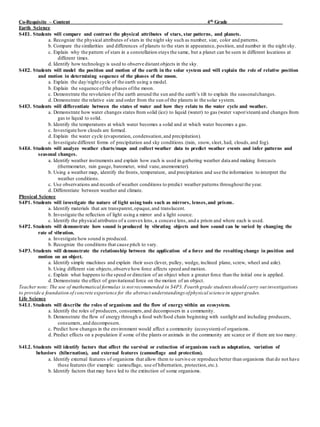Science standards 4th grade content
- 1. Co-Requisite – Content 4th Grade Earth Science S4E1. Students will compare and contrast the physical attributes of stars, star patterns, and planets. a. Recognize the physical attributes of stars in the night sky such as number, size, color and patterns. b. Compare the similarities and differences of planets to the stars in appearance, position, and number in the night sky. c. Explain why the pattern of stars in a constellation stays the same, but a planet can be seen in different locations at different times. d. Identify how technology is used to observe distant objects in the sky. S4E2. Students will model the position and motion of the earth in the solar system and will explain the role of relative position and motion in determining sequence of the phases of the moon. a. Explain the day/night cycle of the earth using a model. b. Explain the sequence ofthe phases ofthe moon. c. Demonstrate the revolution of the earth around the sun and the earth’s tilt to explain the seasonalchanges. d. Demonstrate the relative size and order from the sun of the planets in the solar system. S4E3. Students will differentiate between the states of water and how they relate to the water cycle and weather. a. Demonstrate how water changes states from solid (ice) to liquid (water) to gas (water vapor/steam) and changes from gas to liquid to solid. b. Identify the temperatures at which water becomes a solid and at which water becomes a gas. c. Investigate how clouds are formed. d. Explain the water cycle (evaporation, condensation,and precipitation). e. Investigate different forms of precipitation and sky conditions.(rain, snow, sleet, hail, clouds,and fog). S4E4. Students will analyze weather charts/maps and collect weather data to predict weather events and infer patterns and seasonal changes. a. Identify weather instruments and explain how each is used in gathering weather data and making forecasts (thermometer, rain gauge, barometer, wind vane,anemometer). b. Using a weather map, identify the fronts, temperature, and precipitation and use the information to interpret the weather conditions. c. Use observations and records of weather conditions to predict weather patterns throughout the year. d. Differentiate between weather and climate. Physical Science S4P1. Students will investigate the nature of light using tools such as mirrors, lenses,and prisms. a. Identify materials that are transparent,opaque,and translucent. b. Investigate the reflection of light using a mirror and a light source. c. Identify the physical attributes of a convex lens, a concave lens, and a prism and where each is used. S4P2. Students will demonstrate how sound is produced by vibrating objects and how sound can be varied by changing the rate of vibration. a. Investigate how sound is produced. b. Recognize the conditions that cause pitch to vary. S4P3. Students will demonstrate the relationship between the application of a force and the resulting change in position and motion on an object. a. Identify simple machines and explain their uses (lever, pulley, wedge, inclined plane, screw, wheel and axle). b. Using different size objects,observe how force affects speed and motion. c. Explain what happens to the speed or direction of an object when a greater force than the initial one is applied. d. Demonstrate the effect of gravitational force on the motion of an object. Teacher note: The use of mathematical formulas is not recommended in S4P3. Fourth grade students should carry out investigations to provide a foundation of concrete experience for the abstract understandings ofphysical science in upper grades. Life Science S4L1. Students will describe the roles of organisms and the flow of energy within an ecosystem. a. Identify the roles of producers, consumers,and decomposers in a community. b. Demonstrate the flow of energy through a food web/food chain beginning with sunlight and including producers, consumers, and decomposers. c. Predict how changes in the environment would affect a community (ecosystem) of organisms. d. Predict effects on a population if some of the plants or animals in the community are scarce or if there are too many. S4L2. Students will identify factors that affect the survival or extinction of organisms such as adaptation, variation of behaviors (hibernation), and external features (camouflage and protection). a. Identify external features of organisms that allow them to survive or reproduce better than organisms that do not have these features (for example: camouflage, use of hibernation, protection,etc.). b. Identify factors that may have led to the extinction of some organisms.
